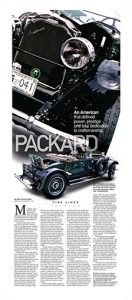 Overview
Overview
Don’t wait for stories to appear in the store when you can become a member of Wheelbase Media’s weekly news service and save more than 50 percent while gaining instant access to the new features as they’re produced. Click here to get started.
If you are not a member of the media, but still wish to check out some of our stories online, visit www.theoctanelounge.com, which is owned by Wheelbase Media.
Use: Media professionals demanding top-quality automotive content for their print products and/or Web sites. Professional artwork, editing.
What it is: Many of you asked if we could put our expertise to work to create a feature that covers not just classic cars, but those vehicles that have left an indelible mark on car culture. The Fine Lines series examines significant vehicle marques, their backgrounds and their contributions to the history of the automobile. All this, with real artwork.
Product specifications
- Mac and PC page layout with accompanying text and
art files for maximum work flexibility. - About 850 words: separate text file included.
- Layout is 8×21.5 inches (newspaper), but can be
reconfigured by your designer to fit most spaces. - PDF of layout included.
- High-resolution artwork suitable for print.
- Includes Photoshop layers file of main art.
- Multi-platform page layout opens with either Quark
Xpress or Adobe Indesign. - Fonts are not included, but we attempt to stay with
standard system fonts. If not, just change the fonts to
match your style.
Description
The beginnings of Packard date back to 1899 when Warren, Ohio-based James Ward Packard, with the help of his brother, made his first single-cylinder horseless carriage. This led to the formation of the Ohio Automobile Company. Packard’s creation became an instant success with sales (and outside financial investment) quickly increasing. Following the relocation of the business to Detroit in 1903, Packards became even more popular, although the company was, for the most part, controlled by wealthy entrepreneur industrialists.
